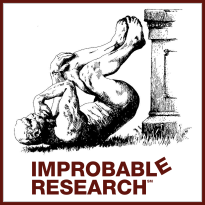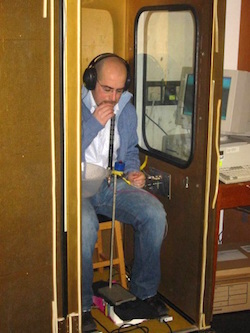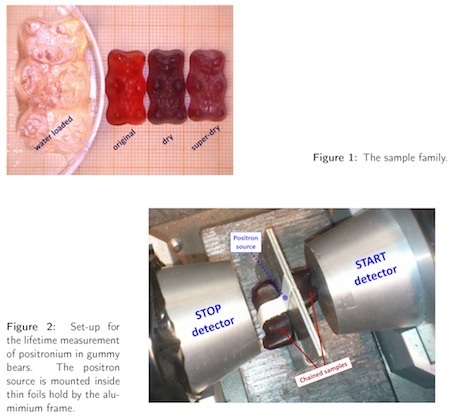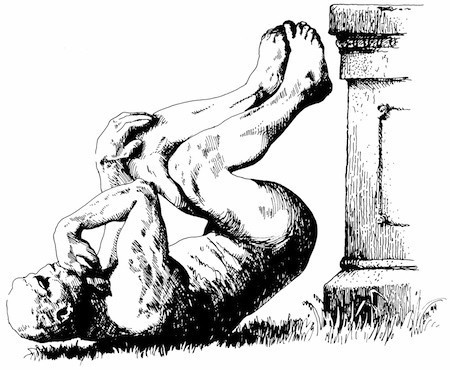Marc Abrahams's Blog, page 342
March 11, 2015
Improbable Research Podcast #2: The proper way to make a cup of tea
 Tea, tea, tea washes through this week’s Improbable Research podcast.
Tea, tea, tea washes through this week’s Improbable Research podcast.
The podcast is all about research that makes people LAUGH, then THINK — research about anything and everything, from everywhere —research that’s good or bad, important or trivial, valuable or worthless. CBS distributes it, both on the new CBS Play.it web site, and on iTunes.
Podcast #2: The Proper Way to Make a Cup of Tea
LISTEN on iTunes or Play.it. (Or DOWNLOAD it, and listen later)
SUBSCRIBE (to receive a new episode, FREE, every week) on iTunes or Play.it.
This week, Marc Abrahams tells about:
The proper way to make a cup of tea. (“Method for Preparation of a Liquor of Tea for Use in Sensory Tests” is standard number BS 6008., 1980. / British Standards Institution.)
Fingernails on a blackboard. (Halpern, D. Lynn, Randolph Blake, and James Hillenbrand (1986). ‘Psychoacoustics of a Chilling Sound.’ Perception and Psychophysics 39: 77–80. / McDermott, Josh, and Marc Hauser (2004). ‘Are Consonant Intervals Music to Their Ears? Spontaneous Acoustic Preferences in a Nonhuman Primate.’ Cognition 94: B11–B21.)
Your mind could kill you. (Wilkens, A. J., B. Zifkin, F. Andermann, and E. McGovern (1982). ‘Seizures induced by thinking.’ Annals of Neurology 11: 608–12. / Yamamoto, Junji, Isao Egawa, Shinobu Yamamoto, and Akira Shimizu (1991). ‘Reflex Epilepsy Induced by Calculation Using a “Soroban”, a Japanese Traditional Calculator.’ Epilepsia 32: 39–43. / Koutroumanidis, M., M. J. Koepp, M. P. Richardson, C. Camfield, A. Agathonikou, S. Ried, A. Papadimitriou, G. T. Plant, J. S. Duncan, and C. P. Panayiotopoulos (1998). ‘The Variants of Reading Epilepsy. A Clinical and Video-EEG Study of 17 Patients with Reading-Induced Seizures.’ Brain 121: 1409–27. / “Seizures Induced by Nursery Rhymes and Children’s Games,” Enrica Bonanni, Chiara Pizzanelli, Michelangelo Maestri, Monica Fabbrini, Renato Galli and Luigi Murri, Seizure, vol. 13, 2004; pp. 282–3. )
Cutting-edge research. (Horsfall, I., C. Watson, S. Champion, P. Prosser, and T. Ringrose (2005). ‘The Effect of Knife Handle Shape on Stabbing Performance.’ Applied Ergonomics 36 (4): 505–11. / Horsfall, I., P. D. Prosser, C. H. Watson, and S. M. Champion (1999). ‘An Assessment of Human Performance in Stabbing.’ Forensic Science International 102 (2-3): 79–89.)
A man who ate knives. (Marcet, Alex. (1823). ‘Account of a Man Who Lived Ten Years After Having Swallowed a Number of Clasp-Knives, with a Description of the Appearances of the Body after Death.’ Medico-Chirurgical Transactions 12 (1): 52–63. / Witcombe, Brian, and Dan Meyer (2006). ‘Sword Swallowing and Its Side Effects.’ BMJ 333: 1285–87.) / Dan Meyer. / Video of the Ig Nobel acceptance speech.)
Cold look at Soviet underwear. (Gurova, Olga (2005). ‘Making of the Body: Cultural History of Underwear in Soviet Russia.’ Paper presented at the Russian, East European, and Eurasian Center, University of Illinois at
Urbana-Champaign, 29 November. / Soviet underwear: between ideology and everyday life , Olga Gurova, Moscow: Novoe literaturnoe obozrenie, 2008. 288 p. ISBN 978-5-86793-647-1.)
Ministry of clowns. (Richter, Angelika, and Lori A. Zonner (1996). ‘Clowning: An Opportunity for Ministry.’ Journal of Religion and Health 35 (2): 141–48. / Miller Van Blerkom, Linda (1995). ‘Clown Doctors: Shaman Healers of Western Medicine.’ Medical Anthropology Quarterly 9 (4): 462–75.) / The clown ministry video.
The mini-opera “What’s Eating You”, Act 1. (The opera premiered as part of the 2014 Ig Nobel Prize ceremony. It starred Maria Ferrante and Scott Taylor, with Patrick Yacono on piano and Thomas Michel on accordion. Karen Hopkin narrates. Also starring the Microbe Chorus: Kelsey Calhoun, Nicholas Carstoiu, Delphine Gabbay, Paul Goodwin, Clia Goodwin, Erika Hutchinson, Andrew B. Jones, Julia Lunetta, Sylvia Rosenberg, Daniel Rosenberg, Abby Schiff, Ted Sharp, and Nobel laureates Carol Greider, Rich Roberts, Frank Wilczek, and Eric Maskin.)
The mysterious Bruce Petschek did the sound engineering.
“Um”ing and “Uh”ing (when dosed with Ketamine)
Many people spontaneously use the word (or sound) “Um” in conversation, a phenomenon which has prompted a considerable volume of academic attention (some of which we discussed recently). A question arises though, can someone be induced to say “Um” by chemical means – say with the use of a powerful anaesthetic? Like, for example Ketamine? [Note: Ketamine is often used as a veterinary tranquilliser, and as an illicit recreational drug under monikers like ‘Special K’ and ‘Cat Valium’]
 The department of Computer Analysis of Speech for Psychological Research (caspr) at The University of Georgia, US, (where it’s said that “Language is a window into the brain”) have examined just such a scenario. Researchers Congzhou He, Michael A. Covington, James Semple and John Brown have looked through the the brain’s window to examine the effects of Ketamine on speech. A poster, presented at the International Congress on Schizophrenia Research, Savannah, April 2005, and entitled : ‘Some linguistic signs of ketamine-induced cognitive impairment‘ describes research (conducted at the University of Cambridge, UK) in which experimental volunteers who were given “low doses” and “high doses” of Ketamine tended to use the words “um” and “uh” significantly more than those who received a placebo only. More “ums” and “uhs” were especially apparent with the high doses. The subjects also had difficulties with verbs and nouns.
The department of Computer Analysis of Speech for Psychological Research (caspr) at The University of Georgia, US, (where it’s said that “Language is a window into the brain”) have examined just such a scenario. Researchers Congzhou He, Michael A. Covington, James Semple and John Brown have looked through the the brain’s window to examine the effects of Ketamine on speech. A poster, presented at the International Congress on Schizophrenia Research, Savannah, April 2005, and entitled : ‘Some linguistic signs of ketamine-induced cognitive impairment‘ describes research (conducted at the University of Cambridge, UK) in which experimental volunteers who were given “low doses” and “high doses” of Ketamine tended to use the words “um” and “uh” significantly more than those who received a placebo only. More “ums” and “uhs” were especially apparent with the high doses. The subjects also had difficulties with verbs and nouns.
Notes:
[1] Authors James Semple and John Brown were representing the pharmaceutical manufacturer GlaxoSmithKline which ‘supported’ the study.
[2] The “high dose” (0.27 mg/kg) was significantly less than the usual ‘anaesthetic dose’ (1 – 4.5 mg/kg) – presumably it had to be, otherwise the subjects might have had considerable difficulty in saying anything.
[3] Please comment below if you know of any other studies in which substances have been shown to influence the number of “ums” a person produces – e.g. cannabis, Dry Martini, dark bitter-chocolate truffles, etc etc.
Ig Nobel EuroTour begins Thursday, at Brunel University
The 2015 Ig Nobel EuroTour begins Thursday night, March 12, at Brunel University. Here are details:
BRUNEL UNIVERSITY, London, UK. Eastern Gateway Building. Thursday, March 12, 7:00 pm. ( TICKETS .) Featuring: Marc Abrahams , Ray Goldstein (Ig Nobel winner, The physics of ponytails); David Dunstan (Effectiveness of throwing snails over the garden fence); Richard Webb (Tribute to John Hoyland , the father of Nominative Determinism); QI/ Museum of Curiosity researcher/performers James Harkin , Dan Schreiber and Stevyn Colgan (dramatic readings from bizarre, genuine research studies); Andrew George (Recitation of bad engineering poetry by the bad poet William Topaz McGonagall )
See the full tour schedule for all the tour events in the UK, Belgium, Denmark, and Sweden.
March 10, 2015
Beach study suggests tourists like good weather
Do not assume that tourists prefer good weather when they visit a beach. A study published in the International Journal of Biometeorology in 2013 challenges that easy-to-make assumption. The researchers gathered evidence – rather than relying on mere guesses and assumptions – as to what kind of weather brings beachgoers to the beach.
Here is what they discovered: “The conditions preferred by beach users, as found in this study, are no precipitation, higher temperatures, light-to-moderate wind speed (less than 30 km/h) and low wave height (up to 1.25m).”
Thus, you need no longer assume tourists prefer good weather when they visit a beach – now you know they do. At least, you know it to the extent that the study’s findings are accurate….
—So begins the latest Improbable Research column in The Guardian.
Flaccid Mechanics: From Penis-Size Statistics to Penis-Size Physics
As recently discussed in this blog and elsewhere, a team of UK researchers have published a new study with the scintillating title of Am I normal? A systematic review and construction of nomograms for flaccid and erect penis length and circumference in up to 15521 men.
The first sentence of the paper’s introduction sums things up rather nicely: “The measurement of penis size may be important either in the assessment of men complaining of a small penis or for academic interest.”
In the authors’ own words, their objective was “To systematically review and create nomograms of flaccid and erect penile size measurements.”
The authors of the paper conducted a statistical study of penis sizes in “up to” 15521 men. I found that to be an odd thing about which to be uncertain—were some people too embarrassed by the result to admit being in the study?—but then it turns out to have a simple explanation: there were actually multiple studies and the 15521 men is the number in the largest one. Their methods included a simulation of 20000 observations of penis size from a normal distribution, though it may also have been interesting to consider a heavy-tailed distribution in case of extreme events.
Importantly, one can also go beyond the statistics of penis sizes to consider the physical properties. A penis could be modeled as a continuum, where the properties such as an elastic constant (to measure stiffness, under the assumption that the object is elastic) and other Lamé parameters are different depending on the state of the penis.
The fluid mechanics of urinating has been studied before, so it seems rather natural to also study the solid mechanics of the penis (aka: “flaccid mechanics”).
March 9, 2015
Jeffrey Guterman joins the Luxuriant FFF Hair Club for Social Scientists (LFFFHCfSS)
Jeffrey Guterman has joined the Luxuriant Flowing, Former, or/and Facial Hair Club for Social Scientists (LFHCfSS). He says:
Jeffrey Guterman is a mental health counselor, educator, and author. He holds a Ph.D. in family therapy from Nova Southeastern University. He is author of the book, Mastering the Art of Solution-Focused Counseling, which was published by the American Counseling Association in 2006. A second edition of this book was published in 2013. In the 1980s, Guterman was influenced by rational emotive behavior therapy (REBT) and received personal psychotherapy, training, and supervision in the model from its founder Albert Ellis. In the 1990s, Guterman developed a solution focused brief therapy model called solution-focused counseling. Solution-focused counseling is an integration of solution-focused principles and techniques, postmodern theories, and a strategic approach to eclecticism.
Jeffrey Guterman, Ph.D, LFFFHCfSS
Mental Health Counselor
Fort Lauderdale, Florida, USA

The uses and meanings of “Um” revisited
Back in 2010, we partially examined the oeuvre of Emanuel A. Schegloff, Professor Emeritus at the Department of Sociology, University of California, Los Angeles. Specifically his work on the meaning of “Uh(m)”s. Perhaps now’s the time to revisit “um” in academia? So may we also recommend the following papers, all of which can be read in their entirety at the click of a mouse.
 ● ‘Using uh and um in spontaneous speaking’ Cognition, 84 (2002) 73–111, by Herbert H. Clark and Jean E. Fox Tree [pictured]
● ‘Using uh and um in spontaneous speaking’ Cognition, 84 (2002) 73–111, by Herbert H. Clark and Jean E. Fox Tree [pictured]
● ‘Showing structure: using um in the academic seminar‘ Pragmatics, 14:4.479-498 (2004) by Johanna Rendle-Short
● ‘Disfluencies Signal Theee, Um: New Information’ Journal of Psycholinguistic Research, Vol. 32, No. 1, 2003, by Jennifer E. Arnold, Maria Fagnano and Michael K. Tanenhaus
● ‘Hesitation disfluencies in spontaneous speech: The meaning of
um‘ Language and Linguistics Compass, 4, 589-602. 2008, by
Martin Corley and Oliver W. Stewart of Philosophy, Psychology, and Language Sciences, University of Edinburgh, Scotland
● ‘On Gender Differences in the Distribution of um and uh’ University of Pennsylvania Working Papers in Linguistics, Vol. 17, Iss. 2 (2011), by Eric K. Acton, Stanford University.
● ‘Does it hurt to say um?‘ Journal of Nonverbal Behavior, 19(3), 1995, by Nicholas Christenfeld
Coming Soon: Um and Language: A window into the brain?
Photo: The picture shows Professor Jean E. Fox Tree of the Spontaneous Communication Laboratory at the University of California Santa Cruz, US, who is a specialist (amongst much more) on ‘ums’. With at least four published papers examining the subject.
Ig Nobel EuroTour begins Thursday, at Brunel University
The 2015 Ig Nobel EuroTour begins Thursday night, March 12, at Brunel University. Here are details:
BRUNEL UNIVERSITY, London, UK. Eastern Gateway Building. Thursday, March 12, 7:00 pm. ( TICKETS .) Featuring: Marc Abrahams , Ray Goldstein (Ig Nobel winner, The physics of ponytails); David Dunstan (Effectiveness of throwing snails over the garden fence); Richard Webb (Tribute to John Hoyland , the father of Nominative Determinism); QI/ Museum of Curiosity researcher/performers James Harkin , Dan Schreiber and Stevyn Colgan (dramatic readings from bizarre, genuine research studies); Andrew George (Recitation of bad engineering poetry by the bad poet William Topaz McGonagall )
See the full tour schedule for all the tour events in the UK, Belgium, Denmark, and Sweden.
March 8, 2015
The sound of flavor: A review of the research
Ig Nobel Prize winner Charles Spence, of Oxford University, has published a new study that reviews much of the research about the flavor of food. The study is:
“Eating with our ears: assessing the importance of the sounds of consumption on our perception and enjoyment of multisensory flavour experiences,” Charles Spence, Flavour, vol. 4, no. 3, 2015. Spence writes:
“Sound is the forgotten flavour sense. You can tell a lot about the texture of a food—think crispy, crunchy, and crackly—from the mastication sounds heard while biting and chewing. The latest techniques from the field of cognitive neuroscience are revolutionizing our understanding of just how important what we hear is to our experience and enjoyment of food and drink. A growing body of research now shows that by synchronizing eating sounds with the act of consumption, one can change a person’s experience of what they think that they are eating.”
 The 2008 Ig Nobel Prize for nutrition was awarded to Massimiliano Zampini of the University of Trento, Italy and Charles Spence of Oxford University, UK, for electronically modifying the sound of a potato chip to make the person chewing the chip believe it to be crisper and fresher than it really is.
The 2008 Ig Nobel Prize for nutrition was awarded to Massimiliano Zampini of the University of Trento, Italy and Charles Spence of Oxford University, UK, for electronically modifying the sound of a potato chip to make the person chewing the chip believe it to be crisper and fresher than it really is.
The prize honored the work documented in the study “The Role of Auditory Cues in Modulating the Perceived Crispness and Staleness of Potato Chips,” Massimiliano Zampini and Charles Spence, Journal of Sensory Studies, vol. 19, October 2004, pp. 347-63. The photo shown here depicts how the research was performed.
March 7, 2015
For gummy bear chem/physics enthusiasts
Gummy bears figure prominently in two recent studies:
“Drying Gummy Bears Reduce Anti-Matter Lifetime,” Christoph Hugenschmidt und Hubert Ceeh. (Thanks to Jan Kuriplach for bringing this to our attention.) The authors are at Technische Universität München, Germany. They write:
“The exotic atom consisting of an electron and its antiparticle, the positron, is a bound state called positronium. Such positronium atoms can be formed by bombarding gummy bears with positrons. In our experiment, we could clearly observe an increased annihilation rate of positronium with increasing degree of drying of the used gelatin-glucose compound. We succeeded in not only measuring the reduced lifetime of positrons in dried jelly baby, but also in quantifying the mean size of the nanoscale pores in the biopolymer, where positronium annihilates.”

and
“Water into Wine,” Benedict Irwin, Peter Hicks, Hannah Lerman, Journal of Physics Special Topics, vol. 12, no. 1,,November 13, 2013, P5_11. The authors, at the University of Leicester, write:
“In the Gospel of John, Jesus turns a substantial quantity of water into wine. We investigate the change in enthalpy across a candidate reaction and determine it to be 1255kJmol-1 indicating an endothermic reaction. We then find the change in entropy to be 4.21kJmol-1 K -1 and calculate the energy required for the whole reaction to be 0.25-0.37GJ.”
Chemical and Engineering News looked into the water/wine study.
Marc Abrahams's Blog
- Marc Abrahams's profile
- 14 followers




